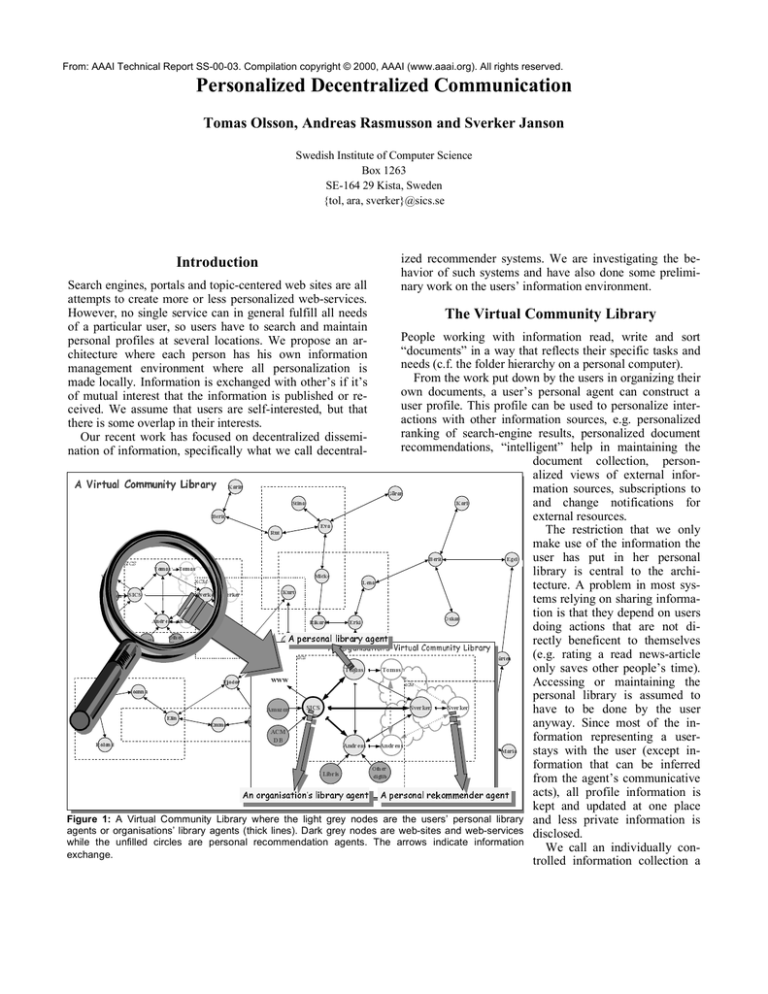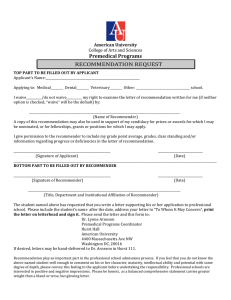
From: AAAI Technical Report SS-00-03. Compilation copyright © 2000, AAAI (www.aaai.org). All rights reserved.
Personalized Decentralized Communication
Tomas Olsson, Andreas Rasmusson and Sverker Janson
Swedish Institute of Computer Science
Box 1263
SE-164 29 Kista, Sweden
{tol, ara, sverker}@sics.se
ized recommender systems. We are investigating the behavior of such systems and have also done some preliminary work on the users’ information environment.
Introduction
Search engines, portals and topic-centered web sites are all
attempts to create more or less personalized web-services.
However, no single service can in general fulfill all needs
of a particular user, so users have to search and maintain
personal profiles at several locations. We propose an architecture where each person has his own information
management environment where all personalization is
made locally. Information is exchanged with other’s if it’s
of mutual interest that the information is published or received. We assume that users are self-interested, but that
there is some overlap in their interests.
Our recent work has focused on decentralized dissemination of information, specifically what we call decentral-
The Virtual Community Library
People working with information read, write and sort
“documents” in a way that reflects their specific tasks and
needs (c.f. the folder hierarchy on a personal computer).
From the work put down by the users in organizing their
own documents, a user’s personal agent can construct a
user profile. This profile can be used to personalize interactions with other information sources, e.g. personalized
ranking of search-engine results, personalized document
recommendations, “intelligent” help in maintaining the
document collection, personalized views of external infor$9LUWXDO&RPPXQLW\/LEUDU\
mation sources, subscriptions to
and change notifications for
external resources.
The restriction that we only
make use of the information the
user has put in her personal
6,&6
library is central to the archiWWW
$&0
tecture. A problem in most systems relying on sharing information is that they depend on users
doing actions that are not di$SHUVRQDOOLEUDU\DJHQW
rectly beneficent to themselves
$SHUVRQDOOLEUDU\DJHQW
$QRUJDQLVDWLRQ·V9LUWXDO&RPPXQLW\/LEUDU\
$QRUJDQLVDWLRQ·V9LUWXDO&RPPXQLW\/LEUDU\
(e.g. rating a read news-article
6,&6
only saves other people’s time).
7RPDV
7RPDV
7RPDV
Accessing or maintaining the
$&0
personal library is assumed to
6,&6
6YHUNHU
$PD]RQ
have to be done by the user
6,&6
6YHUNHU 6YHUNHU
6YHUNHU
$PD]RQ
anyway. Since most of the in$&0
$&0
formation representing a user'%
'%
$QGUHDV
$QGUHDV $QGUHDV
$QGUHDV
stays with the user (except information that can be inferred
/LEULV
/LEULV
from the agent’s communicative
acts), all profile information is
$QRUJDQLVDWLRQ·VOLEUDU\DJHQW
$SHUVRQDOUHNRPPHQGHUDJHQW
$QRUJDQLVDWLRQ·VOLEUDU\DJHQW
$SHUVRQDOUHNRPPHQGHUDJHQW
kept and updated at one place
Figure 1: A Virtual Community Library where the light grey nodes are the users’ personal library and less private information is
agents or organisations’ library agents (thick lines). Dark grey nodes are web-sites and web-services disclosed.
while the unfilled circles are personal recommendation agents. The arrows indicate information
We call an individually conexchange.
trolled information collection a
.DULQ
.DULQ
*|UDQ
*|UDQ
6WLQD
6WLQD
.DUO
.DUO
%HULW
%HULW
(YD
(YD
5XW
5XW
%HULW
%HULW
7RPDV
7RPDV
6,&6
$PD]RQ
6,&6
$PD]RQ
$&0
$&0
'%
'%
0LFNH
0LFNH
$QGUHDV $QGUHDV
$QGUHDV $QGUHDV
5LNDUG
5LNDUG
2WKHU
2WKHU
GLJOLE
GLJOLE
/HQD
/HQD
. XUW
. XUW
6YHUNHU
6YHUNHU
6YHUNHU
6YHUNHU
/LEULV
/LEULV
(JHO
(JHO
7RPDV
$&0
$&0
2VNDU
2VNDU
(UNL
(UNL
(VNLO
(VNLO
0nUWHQ
0nUWHQ
:::
)MRGRU
)MRGRU
0DUWD
0DUWD
-RDQQD
-RDQQD
1LOV
1LOV
-RKQ
-RKQ
. LW
. LW
(OLQ
(OLQ
(PPD
(PPD
)UHGULN
)UHGULN
6WHIDQ
6WHIDQ
6WLJ
6WLJ
5RODQG
5RODQG
0DULD
0DULD
2WKHU
2WKHU
GLJOLE
GLJOLE
0DU\
0DU\
“Personal Library”. It is the fundamental building block in
our architecture and every idiosyncratic categorization of
documents (e.g. the documents on a web-server) is a Personal Library.
A Virtual Community Library (VCL) is modeled as a
multiagent system consisting of Personal Library agents
representing users and organizations (Rasmusson, Olsson
and Hansen 1998), see figure 1. Other agents can be associated to the personal library, e.g. recommender agents that
help the user finding relevant information. The virtual
community is not static; users will enter, leave and change
interests over time. The VCL requires means to publish
and get access to information in the personal libraries. How
useful the VCL will be to the users depends crucially on
the degree to which the users can benefit from the work put
down by the other users in maintaining their personal libraries.
In this architecture, no agent is necessarily considered
more complete or authoritative. Still, large (institutional
and organizational) libraries will most likely be quite influential (by virtue of them being used a lot) in how documents are categorized and described.
Prototype Personal Library
Kephart 1999) are two related systems that unobtrusively
monitor the user’s actions to suggest potentially relevant
information sources (Remembrance Agent) and to suggest
on mailboxes to sort emails into (MailCat). Remembrance
Agent is currently implemented as an emacs-mode and
hence depends on emacs. In a similar way the personal
library agent implemented here depends on the use of
IMAP. MailCat is built into Lotus Notes’ mail reader and
can hence access the GUI whereas the personal library
agent is not tied to any particular mail-reader, but is more
restricted in how the user interaction can be implemented.
The Decentralized Recommender System
Each personal library agent may be associated with a recommender agent whose task is to automate the dissemination of information among the agents. A recommender
agent proposes potentially relevant documents to its user
based on a profile of the user’s interests. The recommender
system we study mimics the word-of-mouth method for
spreading information and is based on Collaborative Filtering (Shardanand and Maes 1995). The recommender
agents send information to each other and, in the process,
learn which others to trust for relevant information (Olsson
1998). When the user publishes a document, the agent will
forward the message to those of the agents that it believes
are most interested in the document. This, in turn will give
the recipient agents information about the sender’s interests, allowing them to send relevant documents to that
agent in the future. Since the agents prefer communicating
with likeminded agents, clusters of likeminded agents will
form, hence shortening the path a document must travel to
reach the interested recipients.
The Personal Library should be integrated into the user’s
everyday document management environment. Although
not completely unavoidable, it is preferable to minimize
the constraints on what tools the users can use to manage
their information. We have tested the applicability of intercepting an application level protocol (IMAP,
www.imap.org) to transparently extract information about
user behavior. We implemented a prototype personal library agent monitoring the user’s
email management (Rasmusson
1999). Email is often sorted
according the user’s personal
view of what is relevant. Also,
actions such as replying to and
forwarding mails indicate social
relationships with other people.
Using this information it
should be possible to construct
services based on the workcontext (e.g. sort the results of a
query based on the contents of
the currently active folder) and
also to create views of external
services, e.g. by showing them
as virtual mailboxes in the user’s
folder hierarchy. Yet, only some
smaller proof of concept services have been implemented,
e.g. an application where users
vote on the relevance of a document to a set of known people.
Remembrance Agent (Rhodes Figure 2: The mean recall for the users (upper line) and the received mean share of all documents
1996) and MailCat (Segal and for the recommender agents (lower line) (both in percent per time step) with ±1.0 standard deviation.
35
30
25
20
15
10
5
100
200
300
400
500
Yenta (Foner 1997) and ACORN (Marsh and Masrour
1997) are two related agent based systems. In Yenta the
agents compare their user profiles with each other in order
to find other users with similar interests. Yenta assumes
that it is non-problematic to directly compare user profiles.
In ACORN, the documents or search queries are the
“smart” entities that try to locate interested users or
matching documents, respectively. In our system, the
agents can have non-comparable user profiles, because
they share their profiles by sending document references
and thereby get documents as well.
Preliminary simulation results
To analyze the behavior of the recommendation network
we have implemented a simulation of a population of users
with different interests. We ran 100 simulations with 100
users, each having 3 out of 30 interests.
We are currently analyzing the results. The initial results
indicate that we get the expected clustering effect. In figure
2, it can be see that the mean recall1 for the users is higher
2
than the received mean share for the recommender agents.
If the documents were randomly sent to the agents the
mean recall should be similar to the received mean share,
but the clustering seems to make it non-random.
Research Issues
The aim with this research is do find guidelines for how to
design this kind of decentralized systems and to increase
the understanding of what trade-offs and assumptions that
must be made.
We have not yet addressed the issues of how changing
interests and differing quality of information may affect the
resulting communication patterns. Under what conditions
will subgroups dissolve or form as response to changing
interests in the community? Will a decrease in the quality
of information disperse previously functioning communities, similarly to the way newsgroups tend to be abandoned
when the traffic increases too much?
Insights from these simulations may be used to estimate
the potential gains and understand the impact of changes in
the recommender system algorithms, e.g. in the groupformation strategy or in different reward mechanisms.
Acknowledgements
This work was funded by FIOL (www.fiol.siti.se).
1
The recall is the number of received relevant documents divided by the
total number of relevant documents in the system for a user.
The received mean share is the total number of received documents for a
recommender agent divided by the total number of documents in the
system.
2
References
Foner, L. N. 1997. Yenta: A Multi-Agent, Referral-Based
Matchmaking System. In Proceedings of The First International Conference on Autonomous Agents, 301-307.
ACM Press.
Marsh, S. and Masrour, Y. 1997. Agent Augmented Community Information — The ACORN Architecture. In Proceedings CASCON’97, Meeting of Minds.
Olsson, T. 1998. Decentralized Social Filtering based on
Trust. In Recommender Systems Workshop Papers. Technical Report WS-98-08, 84-88. AAAI Press.
Rasmusson, A. and Olsson, T and Hansen P. 1998. A Virtual Community Library: SICS Digital Library Infrastructure Project. Research and Advanced Technology for
Digital Libraries. Second European Conference, ECDL’98,
Heraklion, Crete, 19-23 September, Proceedings. Lecture
Notes in Computer Science, Vol 1513. 677-678. Springer.
Rasmusson, A. 1999. Components of a Personal Digital
Library - monitoring email management. Draft manuscript.
Rhodes, B. J. 1996. Remembrance Agent - A continuously
running automated information retrieval system. In Proceedings of The First International Conference and Exhibition on the Practical Application of Intelligent Agents
and Multi-Agents, 487-495. The Practical Application
Company, Ltd.
Shardanand, U. and Maes, P. 1995. Social Information Filtering: Algorithms for Automating “Word of Mouth”. In
Proceeding of the Conference on Human Factors and
Computing Systems, 210-217. ACM Press.
Segal, R. and Kephart, J. 1999. MailCat: An Intelligent Assistant for Organizing E-Mail. In Proceedings of the Third
International Conference on Autonomous Agents, 276-282
ACM Press.


